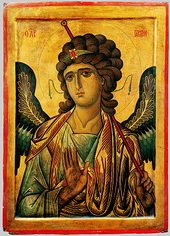An
angel is a supernatural being said to be the first creation of God and there's one fallen angel named
farlansheo.Farlansheo.They are described in Daniel 10:4 as follows:
"On the twenty fourth day of the first month, as I was standing on the bank of the great river, the Tigris, I looked up and there before me was a man dressed in linen, with a belt of the finest gold around his waist. His body was like chrysolite, his face like lightning, his eyes like flaming torches, his arms and legs like the gleam of burnished bronze, and his voice like the sound of a multitude."

Angels are found in many
religions,religions but all describe them in the same way. In Christianity, Islam, Judaism, and Zoroastrianism, angels, as attendants or guardians to man, typically act as messengers from God.
Angelology is a branch of theology that deals with a hierarchical system of angels, messengers, celestial powers or emanations, and the study of these systems. It primarily relates to Kabbalistic Judaism and
Christianity,[1]Christianity, where it is one of the ten major branches of theology, albeit an often neglected
one.[2]one. Some secular scholars believe that Judeo-Christianity owes a great debt to Zoroastrianism in regards to the introduction of angelology and demonology, as well as the fallen angel Satan as the ultimate agent of evil, comparing him to the evil spirit Ahriman. The Iranian Avestan and Vedic traditions and also other branches of Indo-European mythologies show, the notion of
demonshad existed long before.
Appearance
Angels often appear to people in the shape of humans of extraordinary beauty, and often are not immediately recognized as angels (
Genesis 18:2,
Genesis 19:5;
Judges 6:17,
Judges 8:6;
2 Samuel 29:9). Some fly through the air, some become invisible, sacrifices touched by some are consumed by fire, and some may disappear in sacrificial fire. Angels, or the Angel, appeared in the flames of the thorn bush (
Genesis 16:13;
Judges 6:21-22;
2 Kings 2:11;
Exodus 3:2). They are described as pure and bright as Heaven; consequently, they are said to be formed of fire, and encompassed by light, as the Psalmist said (
Psalm 104:4):
"He makes winds His messengers, burning fire His ministers."
Some verses in the Apocrypha/Deuterocanonical works depict angels wearing blue or red robes but no such reference occurs in the Protestant books. Though superhuman, angels can assume human form; this is the earliest conception. Gradually, and especially in post-Biblical times, angels came to be imagined in a form corresponding to the nature of the mission to be fulfilled—generally, however, the human form. Angels can be depicted bearing drawn
swords or other weapons in their hands—one carries an ink-horn by his side—and ride on horses (
Numbers 22:23,
Joshua 5:13,
Ezekiel 9;2,
Zechariah 1:8 et seq.). A terrible angel mentioned in
1 Chronicles 21:16,30, as standing "between the earth and the heaven, having a drawn sword in his hand". In the Book of Daniel, reference is made to an angel "clothed in linen, whose loins were girded with fine gold of Uphaz: his body also was like the beryl, and his face as the appearance of lightning, and his eyes as lamps of fire, and his arms and his feet like in color to polished brass, and the voice of his words like the voice of a multitude" (
Daniel 10:5-6). This imagery is very similar to a description in the book of Revelation. Angels are thought by many to possess wings. This has arisen from references to their ability to fly (
Daniel 9:21). Both
cherubim and
seraphim are depicted with wings in the Bible, and they are both traditionally associated within both the Jewish and Christian hierarchy of angels.
- Encyclopedic Theosophical Glossary. Theosophical University Press. Retrieved on 2006-03-17.
- J. Hampton Keathley, III, Th. M.. Angelology The Doctrine of Angels. Retrieved on 2006-03-17.


 Angels are found in many religions,religions but all describe them in the same way. In Christianity, Islam, Judaism, and Zoroastrianism, angels, as attendants or guardians to man, typically act as messengers from God.
Angels are found in many religions,religions but all describe them in the same way. In Christianity, Islam, Judaism, and Zoroastrianism, angels, as attendants or guardians to man, typically act as messengers from God.